Wild Iris Species in Japan
Hiroshi Shimizu
|
| Japan
is island nation located off the east coast of Asia and is made up of four main
islands, Hokkaido, Honshu, Shikoku and Kyushu. Some 5,000 species of plants
grow in Japan, which no fewer than seven iris species growing in the wild. The
seven irises and their natural hybrids are presented here in order of the
flowering season.
|
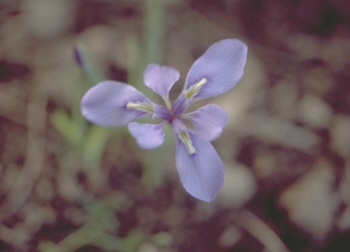 |
| Iris rossii |
Iris
rossii
Iris rossii is a short and slender species which is
rare, even in Japan, and is now on the endangered species list. It grows on dry
sunny hillsides and meadows at forest edges in south Japan and part of western
Japan. The flower are usually shades purple or violet, though there is white
form too. The pure white form I.rossii f.alba is known only from Korea,
however, white color forms are rarely found in Japan.
Most part of the roots which are hairy, very long
and reddish maroon in color cannot take up water, it is only the root tips can
absorb water. Accidental cutting of the root?@tips creates difficulty in
transplanting, therefore propagation from the seed is best. The species grows
on dry banks and in scrub due to the strange characteristics of the roots. It
flowers in April and produces rounded stemless capsules in July. It is said to
be one of the zoochory plants because ants like the seeds and carry them away.
|
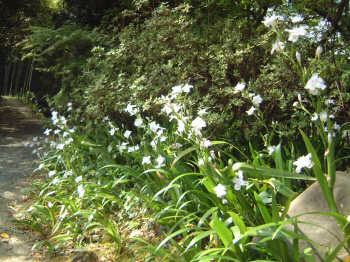 |
| Iris japonica |
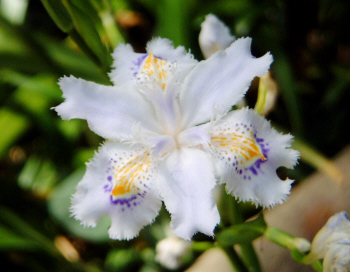 |
| Iris japonica |
Iris
japonica
This species is found in relatively wet grassland
on hillsides, or at the edges of open forests. The nothern limit is latitude 41??N,
but they like warmer places. Many plants escaped into the wild in Japan after
being brought by migrant people from southern China before Christian times.
Among these, I am interested particularly in vigorous triploid plants which are
sterile. For example, Lycoris radiata and Hemerocallis var.fulva var.'Kwanso'.
It is known that their ancestral diploid plants(e.g. L.radiata var.pumila) live
in southern Chaina. I collected seed of Iris japonica f.pallescens at Sichuan
in China some years ago. I collected seed of Iris japonica f.pallescens at
Sichuan in China several years ago. The plant from seed was fertile in itself
and I could get many seeds from reciprocal crossing with bluish color form from
Clarence Mahan of the USA. These two plants had their chromosome numbers
determined by Dr. Yabuya They have 36 chromosomes (2n=36). On the other hand,
Iris japonica in Japan has 54 chromosomes(2n=54). If they have auto-triploid
constitutions, they must be derived from plants
which had 36 chromosomes, such as these two forms. I believe that the
ancestral diploid plant of the Japanese form must be in China. I hope some
expert will collect many forms of Iris japonica and conduct an examination of
their karyotypes. |
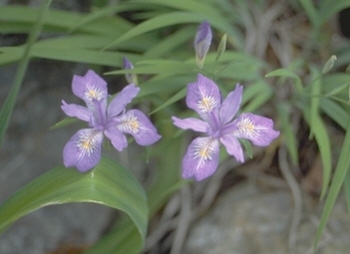 |
| Iris gracilipes |
Iris
gracilipes
The blue-lilac flower of this species is delicate
and lovely. It grows on wooded and rocky mountain slopes or forest edges. Many
plants grow by the seaside, where the north-westerly winter wind off the Asian
continent bring regular heavy snows. The Japanese usually cultivate
I.gracilipes including the beautiful
white form, var. alba, in flatpots, and they flower in May or June.
|
Iris
sanguinea
I.sanguinea grows in wet meadows, damp forest
margins, and on sunny banks. It flowers from May to July and is be found all
over Japan with the exception of Okinawa Island which is located in a
sub-tropical zone.
The flowers in dark reddish-purple and falls have
white hafts with a network of blue-purple veins. Botanists sometimes find it
difficult to distinguish between I.sanguinea and I.sibirica . As a feature of
simple identification, it is said that the flower stalk of I.sanguinea is
non-branching. However, I have found a wild branching form at Karei-highland in
central Honshu.
There are two variants of I.sanguinea in Japan:
var.albiflora and var.violacea.
I.sanguinea var.albiflora is rarely found in the
wild and is not only different in the color of its flower but differs in the
shape of the outer segments. The upper surfaces are strongly concave and
crisped on their margins. I think that the concave form is inherited by the
American cultivar 'White Swirl' (Cassebeer,'57,SIB) and other modern cultivars.
Another variant, I.sanguinea var.violacea,( syn. I.Koreana ) is also
called "Kamayama shobu". The
leaves are narrower and firmer than the typical wild form and the flower is
dark purple.?@It is said to be a native of Korea. In old times, Japanese
farmers put the dry leaved to use as a textile plant in central Honshu. They
often cut off the buds to encourage the development of leaf fiber. It is a
cultivated plant in Japan, never found in the wild. |
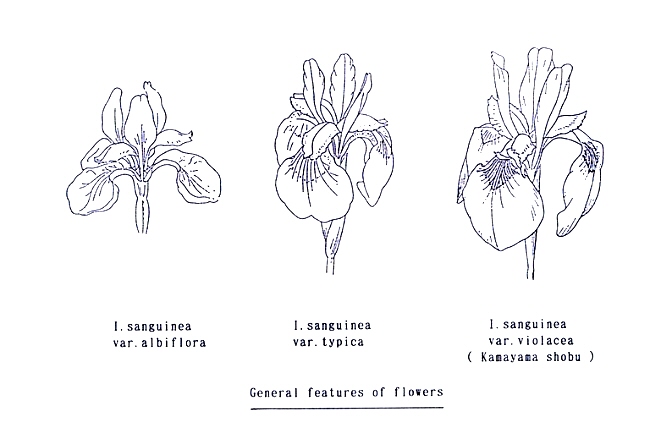 |
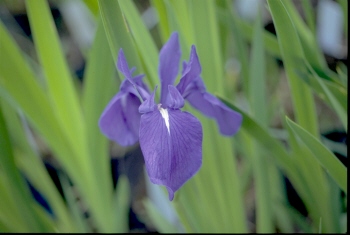 |
| Iris Laevigata |
Iris
laevigata
I.laevigata?@can be found on northern Honshu and is
abundant on Hokkaido, but is rare in other part of Japan. It grows in swamps or
alongside streams and flowers in April and May, but in the highlands and in
north it blooms in June or July. This species has near-white hafts from which
lines extend over the falls. In wild forms the usual flower color range is from
light to deep blue-violet, but occasionally is reddish or white with pale color
tracings on the style arms. Dykes' description in his great monograph was
partially incorrect, it seems to describe a garden form rather than wild form.
|
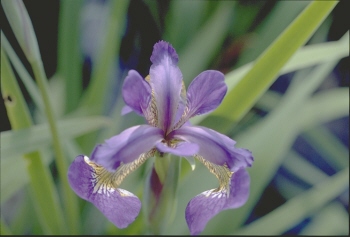 |
| Shiga Ayame(sanguinea X setosa ) |
Iris
setosa
This is the only iris species that is native to
both Asia and North America. It grows in wet meadows, in peaty bogs on Hokkaido
and northern Honshu. Incentral Honshu it occurs in wet sub-alpine meadows
between the altitudes of 1,500-2,500 meters. It flowers in July. Many variants
are known around the world and there are two variants in Japan - var.honednsis
and var.nasuensis. Iris setosa var.hondensis was discovered at
Kirigamine-highland in 1930 by Dr.Honda. It has broader leaves, larger, more
purple flowers and longer flower stalks than the typical wild form and is sold
as a triploid form in America under the name "Kirigamine." I.setosa
var. nasuensis occurred at Nasu-highland in central Honshu. The Japanese
Emperor Showa, known to you Hirohito, was involved in the discovery of this
variant. He made a long visit every summer to Nasu-imperial-village and made
investigations into many plants there. His plant collecting partner,
Dr.Kawamura, found it first and reported it to Emperor Showa in 1961.Emperor
showa was very interested and collected a specimen of following year. At
present, it is kept as the type specimen at Tokyo University Museum. These two
variants are very much alike.
Japanese
botanists pay attention to the shape of the inner perianths (standards).
I.setosa var.setosa, the typical wild form, has trullate (Shaped like a
bricklayer's trowel) inner perianths, in var. nasuensis they are pandurate,
(Shaped like a fiddle or the blade of paddle) and in var.hondoensis they are
spatulate. At present, a Japanese botanist, Dr.Iwashina, is doing research into
them by phyto-chemical analysis of plant products. He was very interested in
I.setosa var.Canadensis, as it has spatulate inner perianths such as in
var.hondoensis. I have sent him a few plants of var.canadensis collected in the
wild by Tony Huber of Canada. It proved that I.setosa var. canadensis is
phyto-chemically very different from the three Japanese variants. Var.nasuensis
and var.hondoensis are thought to be hybrids of I.setosa( tetraploid) and
I.laevigata. Their chromosome numbers are 2n=54. However, there is a
discrepancy in the description of honednsie's description. The typicall wild
form var.setosa, which is a parent of hondoensis, The typical wild form
var.setosa, which is a parent of var. hondoensis, does not live in
Kirigamine-highland. There is a third natural hybrid of I.setosa found in
Japan. "Shiga Ayame" is a hybrid of I.setosa and I.sanguinea. It was
found in Shiga-highland in central Honshu in 1930 by Dr.Yokouchi and
Mr.Koidzumi, and was named after the area in which it was discovered. The inner
perianths of this iris are an intermediate type between two parents. These
three hybrids of I.setosa are found only in limited areas of Honshu.
|
 |
 |
 |
| Iris setosa var.setosa |
Iris setosa var.nasuensis |
Iris setosa var.hondoensis |
|
|
Iris
ensata
This
species grows in damp areas beside lakes or rivers on the mountains of Hokkaido,
Honshu, Shikoku, and Kyushu. The flowering season is in July.
The
typical wild form of this species has yellow lines extending from the hafts of
the falls. There are many garden forms with large flowers., sometimes double
and often with spreading rather than erect standards. There are two color
varieties of the wild form.
A
botanist, late Dr. Miyoshi, named the red-purple form var.typica and the
blue-violet form var.violacea. According to my little investigation,
var.violacea grows only around an altitude of 800 meter in Hakone and Mt. Fuji.
However, modern Japanese botanists do not recognize the two forms as distinct,
because they sometimes grow in the same area and the intermediate type between
typica and violacea also grows there.
When we think about the origin of many cultivar of Iris ensata, the
existence of two varieties is very important. We can distinguish var.violacea
and blue-violet cultivars from var.typica and red-purple color cultivars by the
phyto-chemical method, but not visually. Perhaps modern cultivars will come
from the hybrid of these two varieties.
There
is a pink flower in wild ensata which was found in northern Honshu in 1980 by
Mr.higashida . I registered it with Japan Iris Society (JIS) under the name
"Kita no tenshi."('Angel of Northern Land') Though it resemble 'Rose
Queen' (Lilley,'15), its pink color is more clear and the shape of its outer
perianth tips is more pointed. A Japanese hybridizer has said that 'Rose Queen'
may be a pink flower from Siberia, because the flower shape looks like the wild
species found in Siberia. If true, 'Rose Queen' must have a different genetic
background from modern cultivars.
When
we think about the origin of species we should pay attention to pollinators. I
think Siberian species of I.ensata will have different pollinators from
Japanese species because of the tightness of style branches and outer
perianths. Bumble bees bigger than honey bees cannot force their way in between
styles and outer perianths in Siberian flowers. On the other hand, bigger bumble
bees can go to the floral nectary in Japanese species flower, because the
junction between style branches and outer perianths is looser.
Seven iris species and three hybrids grow wild
in Japan as I have described. There are a few mysteries involving their
distribution. For example: where was I.japonica lives in Japan developed, and
how did it come to Japan ? It is said
that I.sanguinea var.violacea is native to Korea. Does it really grow in Korea
? A Japanese says that it is a hybrid of
I.sibrica and I.sanguinea. But I think I.siberica is not found in Korea. Some
Japanese botanists believe that it was selected from the wild form and grown to
make textiles in Japan. Perhaps we will be able to obtain the anthswers by
phyto-geographical investigation in Eastern Asia.
|

TOP:var.Violacea Right:var.typica
Below:var.typica paller color
 |
 |
| Wild Species in Northern Honshu. |
 |
| pale colored mutant |
Wild Easata and Hemerocallis in Northern Honshu. |
 |
 |
| white colored mutant |
Pink colored mutant |
|
 |